
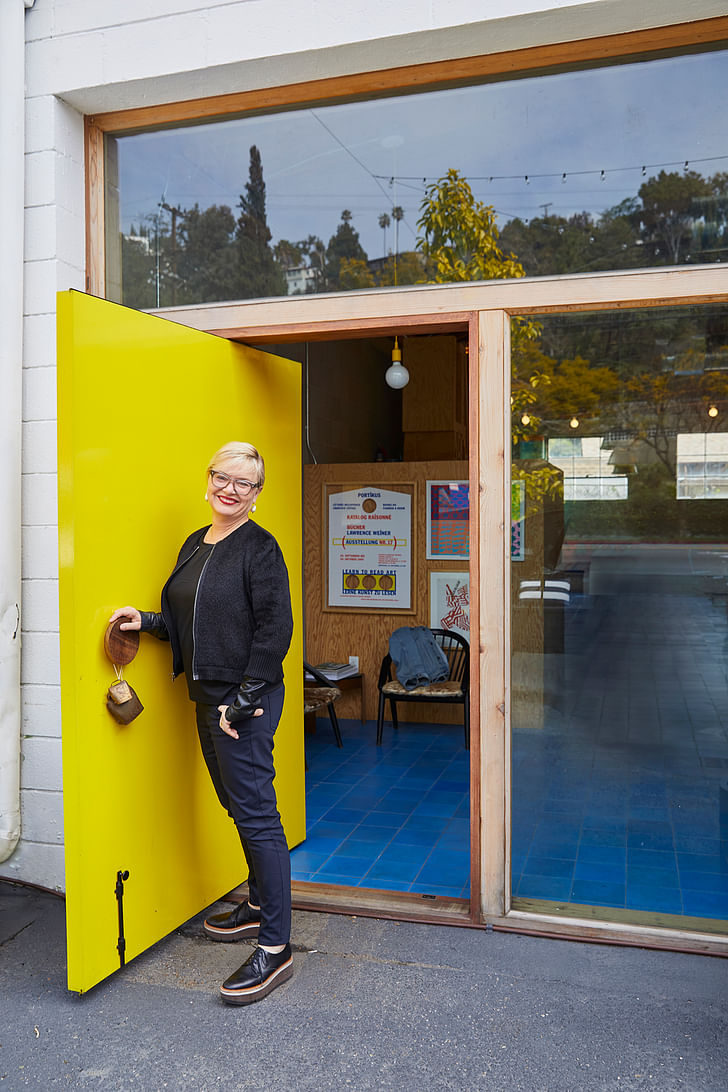
Since 1995, Bestor Architecture has upended architecture and design by infusing their projects with a bold use of pattern, color, and graphics. The steadily growing practice is almost single-handedly responsible for generating California’s now-ubiquitous “Bohemian Modern” style that blends Mid-Century Modern formalism with earthy materiality and contemporary image culture references to generate a cool but comfortable aesthetic that has global appeal.
Known mainly for ground-breaking residential designs, lively office interiors, and tasteful historic restorations, as Bestor Architecture hits its mid-20s, the firm has its sights set on going even bigger. With her finger on the pulse of contemporary culture and a self-motivated staff in the office, firm founder and principal Barbara Bestor is striving to broaden her reach to include transformative urbanism, housing, the 2028 Olympics, and more.
For our latest Studio Visit, Archinect’s Paul Petrunia got in touch with Bestor to dig into where she finds inspiration, what drives her practice, and where she sees Bestor Architecture headed as Los Angeles transforms itself for the future.
You didn’t grow up in L.A., did you?
No, I grew up in Cambridge, Massachusetts in the 1970s and 1980s.
You have a reputation in L.A. for attracting a creative crowd. Did you grow up in a creative household?
I grew up in an academic household, but I think there was a lot of creative stuff in my neighborhood. And I really feel like I got into the architecture world through babysitting—I babysat for all these architects and I got really into the spaces people were building for themselves. Cambridge is made up mostly of older houses, but people would really go kind of wild on the inside with modern interior changes.

Did you jump right in to architecture when you went to college?
I was pretty sure I would go to architecture grad school, so I intentionally did an undergrad degree in art. Eventually, I took a year off to go to the Architectural Association in London and studied architecture there for a year. That was a huge influence on me—it’s how I ended up in L.A. Everyone at the AA was like, “if you want to build experimental architecture in America, go to L.A.”
You had emissaries like Peter Cook and Alvin Boyarsky were going back and forth at the time (the 1980s). I ended up getting a job with Morphosis for the following summer, so that set me up to move out here and then I went to SCI-Arc for grad school.
I’m glad I didn't go through a more homogenous educational path. I think thats the big trick in architecture, to try and not get stuck in a single path that says: “This is true.”
What was the biggest inspiration for you while you were at the AA?
What was most exciting was the amount of very different discursive and visual positions that people had there. It was a time in England where there was a huge recession on, so there weren't a lot of architecture jobs, but there was a lot of creative paper architecture and a lot of people doing imaginative, speculative architecture with different ideological, political, and aesthetic intentions. It was super influential in that it opened me up to a lot of ideas. There was also, interestingly, a new emphasis on perspective drawing and on a way of looking at architecture through images of architecture (This predated renderings). A lot of people teaching there had worked for Bernard Tschumi and had worked on Parc de la Villette. There was a real emphasis on drawing, aesthetic expression, and the influence of those things on how we live and on how the city works. That's what I loved about it—It was very liberating.
I’m glad I didn't go through a more homogenous educational path. I think thats the big trick in architecture, to try and not get stuck in a single path that says: “This is true.”
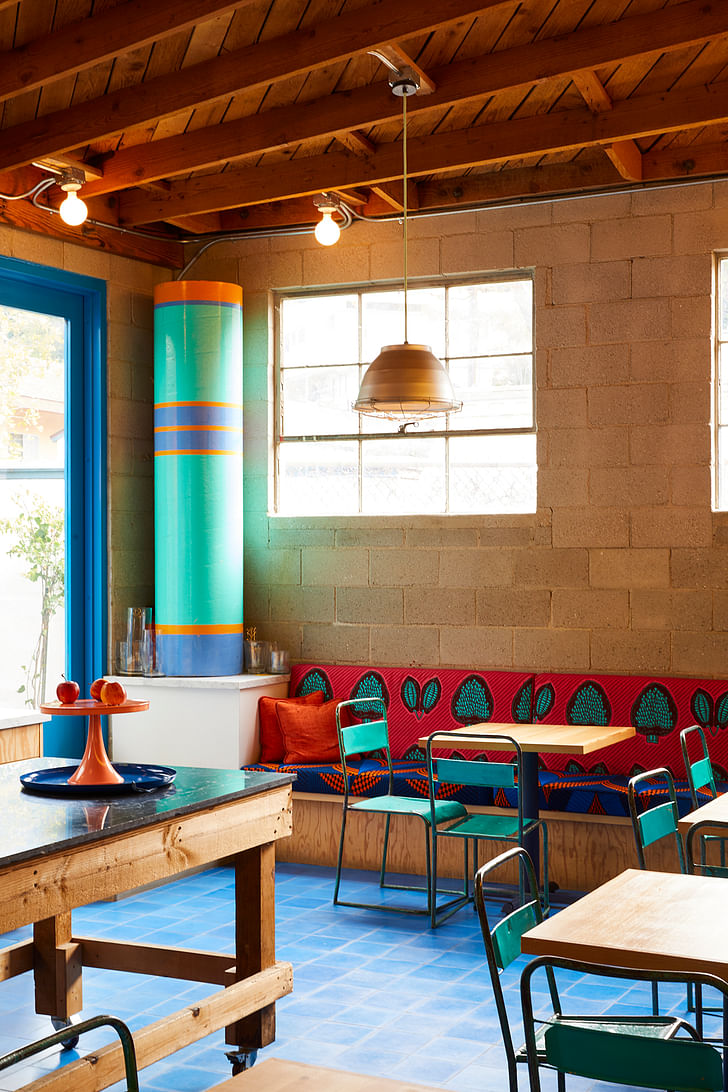
I learned a lot over time, like how to stake out what it is that I wanted to do in architecture and how to try and get those projects. You have to keep telling everyone what types of projects you want and sometimes that actually works out.
How did attending SCI-Arc afterward change you as an aspiring architect?
It was amazing. I think I really lucked out just in terms of the timing and what was going on there then. It was a really heady time because there wasn't a ton of building going on, but there were a lot of creative ideas flowing, and people thought of L.A. as a place where you could try out ideas that might be in part inspired, perhaps, by a connection to Hollywood and to all the other creative production going on here, as well.
So when you finished SCI-Arc did you start your practice right away?
I did work in other architecture firms, but pretty soon I got a bunch of really small projects where I’d do the design and some of the fabrication. I did a bunch of funny home offices where I designed all the furniture and created very detailed space plans, for example. My friend Norman Millar joined me on a pitch for a house project for some friends of friends that eventually led to me starting my own firm. We had a joint venture and basically shared overhead for five years; It was very nice for someone starting out. I’d say I did about 10 years’ worth of bazillions of little gigs. And I was also teaching three days a week at SCI-Arc at the time and at UCLA before that. I liked that world, but it took a while to get into a bigger scale. I learned a lot over time, like how to stake out what it is that I wanted to do in architecture and how to try and get those projects. You have to keep telling everyone what types of projects you want and sometimes that actually works out.
I think I did about 400 kitchen remodels—I mean, I’d do literally everything, including small parking structures. My hero in architecture is Rudolf Schindler, and there’s a story about him driving around L.A. with 2x4s in the back of his car. And I like that part of architecture, where there’s enough room to experiment on the building side of things. It's one of the more difficult things in architecture to do.
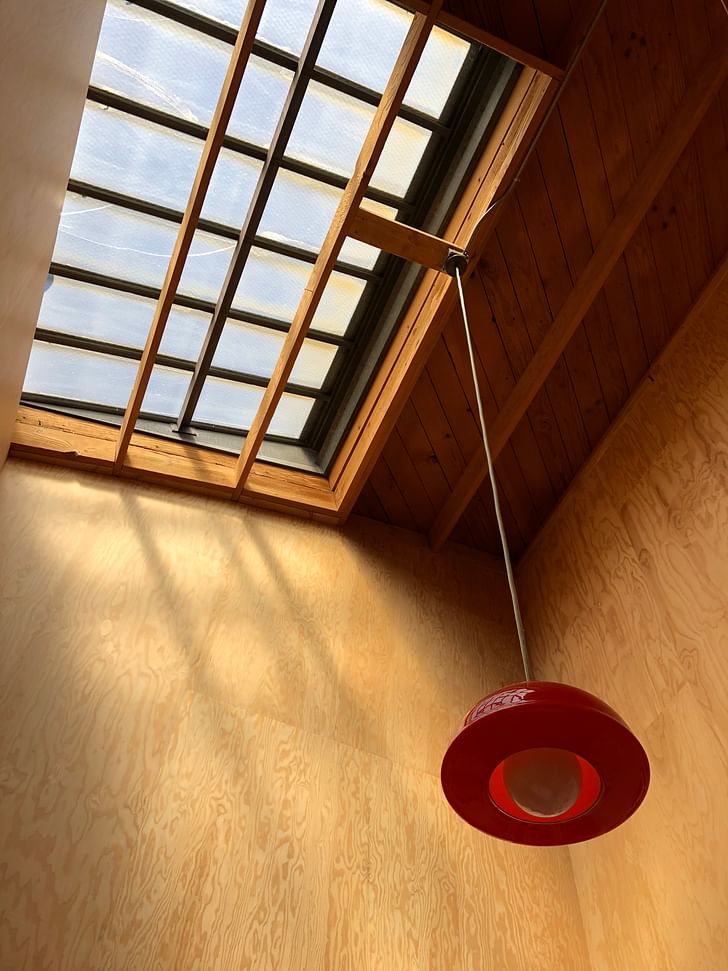
My hero in architecture is Rudolf Schindler, and there’s a story about him driving around L.A. with 2x4s in the back of his car. And I like that part of architecture, where there’s enough room to experiment on the building side of things.
Were there times early on that you were stuck working on projects you weren't really happy with?
I don't think I was ever cynical about my work, but for sure in the early 90s, I did a few let’s say “Spanish-y” / Wallace Neff-inspired remodels in Santa Monica because that was the work that would actually pay. And yeah, I would never publish those now—and I love Wallace—but it’s not what I am particularly interested in. You learn a lot no matter what you're doing, though, and I would say I was less ideologically snobby back then.
360º view of Barbara Bestor's studio, by Paul Petrunia
Now, I can be snobby because I want to keep building on the things I want to do architecturally.
But one of the things that is useful if you want to start a solo practice or start a firm of any kind is liking clients and the whole process. Sometimes you’ll start a job and you won’t realize until midway through that your client is more conservative than you originally thought. Then, you just have to do a really beautiful version of what they want.
I don’t do that so much nowadays, but I didn't find it problematic or soul-crushing to do it early on because ultimately we are in a service industry and not everything can be discursive.
But one of the things that is useful if you want to start a solo practice or start a firm of any kind is liking clients and the whole process. Sometimes you’ll start a job and you won’t realize until midway through that your client is more conservative than you originally thought. Then, you just have to do a really beautiful version of what they want.
Have you found as you've built up your body of work over the years that your potential clients have a better understanding of what they're getting?
Oh yes. As of ten years ago, clients started saying they like things that I've done or want to know what I’d do with a particular brief. Lately, it's allowed me to engage with late Twentieth Century history, for example, which I have a geeky interest about.
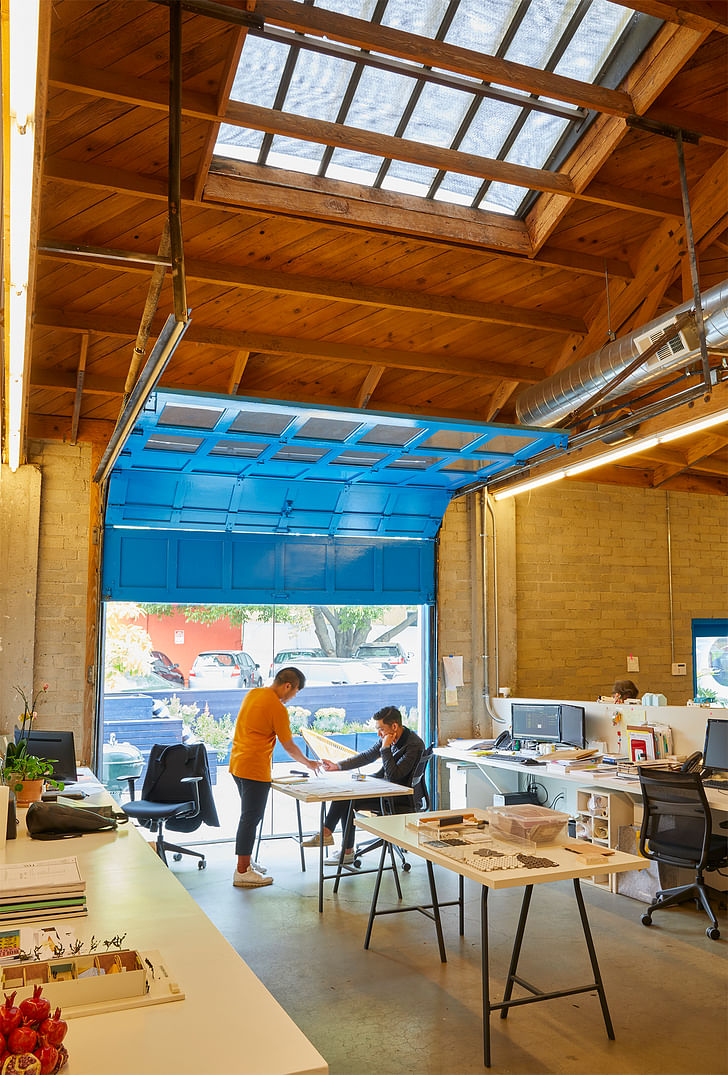
Your practice has a lot of interests outside of architecture that you incorporate into your work. It’s very visual, for example. What are some of your outside interests that you like to bring into the work you do?
I had a motto for the office early on that said, “Everyone should experience strange beauty every day.” It had a double meaning as far as using art to make architecture strange and modern. I am super not into junkspace and “the generic.” In my mind, though, most corporate architecture these days falls into those categories.
Instead, I think that my job is to create qualitatively different architectural experiences for people. Sometimes I like to say that we design atmospheres, which allows us to do interiors and exhibition designs, as well as new structures that are hopefully immersive enough to get people off their screens.
People who are not in architecture—interiors, graphics, film, and virtual reality people, for example—are constantly adding to the tools we have at our disposal and I like engaging with that. I am interested in bigger issues, like what it means to be human in the 21st century.
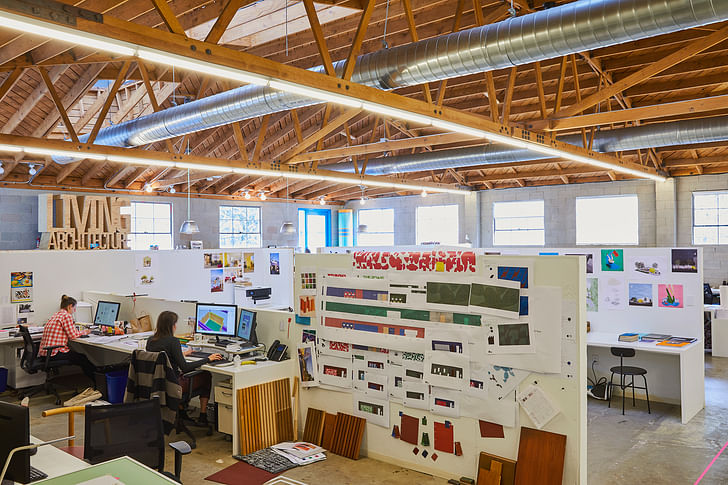
Do you find art inspires your architecture?
Yes, I am interested in uncovering which aspects of visual culture speak to us now and how those things might translate into architecture. I also like thinking about how architects as cultural producers might learn from what's going on in the larger culture to make architecture more communicative and immersive.
Many people say your work reflects the culture and feeling of Los Angeles and California. Do you see your work that way?
I do, but in a way, some of my work is reflective of how and where I grew up. In the beginning, I was more orthodox and had traditional Modernist concerns, but I got rid of that and then got more interested in things that I actually like. I discovered that shape is okay, for example, and that sometimes, making associations between your work and that of others can be useful, among other ideas.
360º view of Barbara Bestor's personal office, by Paul Petrunia
So this studio that you're in right now is a relatively new studio. You've been here for, what, like a year and a half?
Yeah, we moved in October 2017, so a little over two years.
And you just moved down the road from your old office, where you were in an iconic space. I mean, as a resident of Silver Lake for years, I would drive by all the time, and it was always fun to watch the different super graphics change outside of that space over time—What instigated that move?
We went from 8 to 15 employees and our old offices became too cramped. It seemed better for us to all be in the same place and I wanted to have something that I could invest in where I could be for the long-haul. I found a raw warehouse near our old offices and so we made a deal where we signed a 20-year lease and did a huge build-out at our own expense. Now, we have 6,500 square feet and are at about 26 people right now. The building can be divided into three parts that can be sublet separately, if need be. Right now, we have the front part of the office as a defacto art gallery. It’s kind of nice to have a community art space there for now.
I am naturally very gregarious and curious. And that has always been very helpful professionally because I think our profession attracts obsessive introverts. So for me, by being gregarious and persuasive, I can help steer any of the projects we take on so they turn out well. I will not let things turn out badly. Ultimately, my interest is that if we are going to do something that we do it really well.
What are some of the recent shows you've had?
We did a show with Bettina Hubby, who created something called Curatorial Hub, a neat virtual gallery with all these interesting younger artists she represents. She set up a website for those artists, but then, we did a weekend-long, bricks-and-mortar manifestation of the website to show off all those different peoples’ work. 300 people came and it was kind of a big celebration.
You're one of those figures in Los Angeles that a lot of people know—You look almost surprised to hear that—I've always assumed that you're just naturally a very social person. How does that play into your work, your engagement with others in the physical world? I know that you throw some pretty epic parties, especially Halloween parties, at the Mexican restaurant down the street.
Oh, yeah, [Casita Del Campo] is now conveniently three doors away.
Are those parties a part of your work? Does that enhance your professional life? Or is that just you just being you?
It's pretty much me being me. It probably has enhanced my professional life to some degree, although I don't know, honestly. My friend John and I [throw those parties] and we consider it a sort of community service thing. We do it like once or twice a year and it's usually like 400 or 500 people. It's kind of fun. It's one of those things where you run into people you haven't seen for 15 years or something.
And it involves dancing for people over 30, so that's cool.
I am naturally very gregarious and curious. And that has always been very helpful professionally because I think our profession attracts obsessive introverts. So for me, by being gregarious and persuasive, I can help steer any of the projects we take on so they turn out well. I will not let things turn out badly. Ultimately, my interest is that if we are going to do something that we do it really well. But it does involve a lot of people skills and I think that’s the part where it’s a lot easier to run an office if you're a people pleaser. It helps professionally.
So going back to this new space, it sounds like this new space was the result of a number of lessons that you learned through previous workspaces. What are some of the lessons you learned from your previous work spaces and how were you able to finally create a space that you plan on being in for a long time?
The big thing I wanted to do was set up something where the whole entry and primary experience was a social space. We do a lot of restaurants, retail, and offices, and I think putting the office community first is key. We have a very generous kitchen zone with seating that’s way more designed than the rest of the office. And it has become a space that everybody circulates through. We also have really nice bathrooms, which I think is important. This space has turned out really well for informal meetings.
We have a big group lunch every Friday that we cater, but also, people generally bring their lunch and hang out there, and we have informal meetings there. And then, we have all the kind of stuff that we end up needing to have for our projects that are like more formal, like conference rooms and video stuff. Pretty much, though, it's an open office layout.
It's a very social office, very social. And actually people went to Casita Del Campo last night after work; I couldn't go, I was bummed. I would say that the people that work here, generally, are really nice. And that's part of our hiring policy. It's like: let's just make sure people are nice.
You guys do anything as a team. Do you guys go out at night or do you ever go on retreats or anything like that?
There was a karaoke thing not that long ago, we've had a couple a day-long retreats in L.A. but just to go through “what are we doing here,” etc. We're talking about doing a weekend in Phoenix and staying at the Biltmore and going to the Taliesin. If I can get Aaron Betsky to let us run wild at Taliesin, that would be super fun. But there's a lot of us right now who are working so much. We've been super busy. So a lot of us are doing like, 50, 60 hour weeks regularly. And so, we're all here until like eight, which is not what my studio culture used to be, it’s not mandatory at all, but its just working out that way on a couple of our corporate projects.
So when do people come into the office?
That varies a lot. I'm not really into a hard, hard start time, no. Really, the people that do well here are pretty independent. And also, I like the idea of the architect who's the designer, the project architect, the project manager, you know, kind of the the more holistic model. And that's kind of what I train people to to do here. And so some people are really good at that.
Do you see the practice growing in scale over the next 10 or 20 years?
What they say is true: I hit 50 and I am now I’m getting to do bigger projects, which is cool. I am excited for the next decade or so because it's a really exciting time for L.A., which is a nice coincidence. There’s going to be a lot happening here and I’ve worked hard to create a reputation that allows me access to projects or ideas I would not have had otherwise.
In terms of scaling up, I don’t really know. I’m trying to see what happens. I don't particularly have a desire to be a bigger operation. I would like to be doing more ground-up buildings and have done a fair number of larger projects lately, though, and I’m trying to make sure I keep my eye on that.
But I'm anxious to get more stuff built.
Antonio is a Los Angeles-based writer, designer, and preservationist. He completed the M.Arch I and Master of Preservation Studies programs at Tulane University in 2014, and earned a Bachelor of Arts in Architecture from Washington University in St. Louis in 2010. Antonio has written extensively ...
Paul Petrunia is the founder and director of Archinect, a (mostly) online publication/resource founded in 1997 to establish a more connected community of architects, students, designers and fans of the designed environment. Outside of managing his growing team of writers, editors, designers and ...
No Comments
Barbara is really a good Los Angeles architect. She knows the nomenclature of LA architecture and does creative and fun things with them. She reminds me my one time boss Brian Murphy who is few years older and knows how to build and tweak vernacular and modern architecture. Even his garage remodels would go on to the cover of PA Magazine. He used to say "if my work puts a smile on people's face, I've done a good job."
One time I walked around a few blocks with Barbara Bestor near her office and really enjoyed looking at houses in the neighborhood and talk about them with her. She has a similar way of talking about architecture and connecting it with people.
Nice interview Archinect.
Block this user
Are you sure you want to block this user and hide all related comments throughout the site?
Archinect
This is your first comment on Archinect. Your comment will be visible once approved.